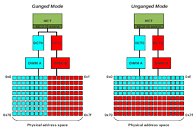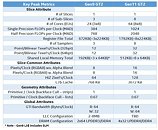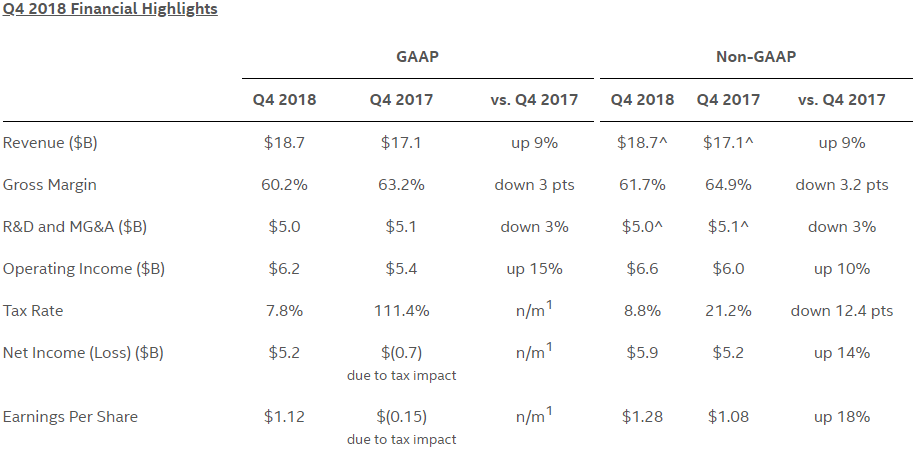- Joined
- Oct 9, 2007
- Messages
- 47,783 (7.40/day)
- Location
- Dublin, Ireland
| System Name | RBMK-1000 |
|---|---|
| Processor | AMD Ryzen 7 5700G |
| Motherboard | Gigabyte B550 AORUS Elite V2 |
| Cooling | DeepCool Gammax L240 V2 |
| Memory | 2x 16GB DDR4-3200 |
| Video Card(s) | Galax RTX 4070 Ti EX |
| Storage | Samsung 990 1TB |
| Display(s) | BenQ 1440p 60 Hz 27-inch |
| Case | Corsair Carbide 100R |
| Audio Device(s) | ASUS SupremeFX S1220A |
| Power Supply | Cooler Master MWE Gold 650W |
| Mouse | ASUS ROG Strix Impact |
| Keyboard | Gamdias Hermes E2 |
| Software | Windows 11 Pro |
When reading through the Gen11 GT2 whitepaper by Intel, which describes their upcoming integrated graphics architecture, we may have found a groundbreaking piece of information that concerns the memory architecture of computers running 10 nm "Ice Lake" processors. The whitepaper mentions the chip to feature a 4x32-bit LPDDR4/DDR4 interface as opposed to the 2x64-bit LPDDR4/DDR4 interface of current-generation chips such as "Coffee Lake." This is strong evidence that Intel's new architecture will have unganged dual-channel memory controllers (2x 64-bit), as opposed to the monolithic 128-bit IMC found on current-generation chips.
An unganged dual-channel memory interface consists of two independent memory controllers, each handling a 64-bit wide memory channel. This approach lets the processor execute two operations in tandem, given the accesses go to distinct memory banks. On top of that it's now possible to read and write at the same time, something that's can't be done in 128-bit memory mode. From a processor's perspective DRAM is very slow, and what takes up most of the time (= latency), is opening the memory and preparing the read/write operation - the actual data transfer is fairly quick.


With two independent memory controllers these latencies can be mitigated, in several ways in unganged mode. While single-threaded workloads, or workloads that operate on a relatively small problem set, benefit more from ganged mode, unganged mode can shine when multiple (or multi-threaded) applications work with vast amounts of memory, which increases the likelihood that two independent banks of memory get accessed. Perhaps unganged-aware software, such as OS-level memory management could help make the most out of unganged mode, by trying to spread out processes evenly throughout the physical memory, so independent memory accesses can be executed as often as possible.
For integrated graphics, unganged mode is a real killer application though. The iGPU reserves a chunk of system memory for geometry, textures and framebuffer. This memory range is typically placed at the end of the physical memory space, whereas the Windows OS and applications usually are located near the start of physical memory. This effectively gives the GPU its own dedicated memory controller, which also reduces memory latency, because one controller can hold the IGP's memory pages open almost all the time, whereas the second controller takes care of the OS and application memory requests.
AMD has been supporting unganged dual-channel memory interfaces for over a decade now. The company's first Phenom processors introduced unganged memory with a BIOS option to force the CPU to interleave all data, called ganged mode. The consensus among the tech-community over the past ten years and the evolution of the modern processor toward more parallelism favors unganged mode. With CPU core counts heading north of 8 for mainstream-desktop processors, and integrated GPUs becoming the norm, it was natural for Intel to add support for an unganged memory interface.
Image Courtesy: ilsistemista.net
View at TechPowerUp Main Site
An unganged dual-channel memory interface consists of two independent memory controllers, each handling a 64-bit wide memory channel. This approach lets the processor execute two operations in tandem, given the accesses go to distinct memory banks. On top of that it's now possible to read and write at the same time, something that's can't be done in 128-bit memory mode. From a processor's perspective DRAM is very slow, and what takes up most of the time (= latency), is opening the memory and preparing the read/write operation - the actual data transfer is fairly quick.


With two independent memory controllers these latencies can be mitigated, in several ways in unganged mode. While single-threaded workloads, or workloads that operate on a relatively small problem set, benefit more from ganged mode, unganged mode can shine when multiple (or multi-threaded) applications work with vast amounts of memory, which increases the likelihood that two independent banks of memory get accessed. Perhaps unganged-aware software, such as OS-level memory management could help make the most out of unganged mode, by trying to spread out processes evenly throughout the physical memory, so independent memory accesses can be executed as often as possible.
For integrated graphics, unganged mode is a real killer application though. The iGPU reserves a chunk of system memory for geometry, textures and framebuffer. This memory range is typically placed at the end of the physical memory space, whereas the Windows OS and applications usually are located near the start of physical memory. This effectively gives the GPU its own dedicated memory controller, which also reduces memory latency, because one controller can hold the IGP's memory pages open almost all the time, whereas the second controller takes care of the OS and application memory requests.
AMD has been supporting unganged dual-channel memory interfaces for over a decade now. The company's first Phenom processors introduced unganged memory with a BIOS option to force the CPU to interleave all data, called ganged mode. The consensus among the tech-community over the past ten years and the evolution of the modern processor toward more parallelism favors unganged mode. With CPU core counts heading north of 8 for mainstream-desktop processors, and integrated GPUs becoming the norm, it was natural for Intel to add support for an unganged memory interface.
Image Courtesy: ilsistemista.net
View at TechPowerUp Main Site







